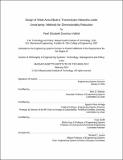Design of wide-area electric transmission networks under uncertainty : methods for dimensionality reduction
Author(s)
Donohoo-Vallett, Pearl Elizabeth
DownloadFull printable version (2.076Mb)
Other Contributors
Massachusetts Institute of Technology. Engineering Systems Division.
Advisor
Mort Webster and Ignacio Pérez-Arriaga.
Terms of use
Metadata
Show full item recordAbstract
The growth of location-constrained renewable generators and the integration of electricity markets in the United States and Europe are forcing transmission planners to consider the design of interconnection-wide systems. In this context, planners are analyzing major topological changes to the electric transmission system rather than more traditional questions of system reinforcement. Unlike a regional reinforcement problem where a planner may study tens of investments, the wide-area planning problem may consider thousands of investments. Complicating this already challenging problem is uncertainty with respect to future renewable-generation location. Transmission access, however, is imperative for these resources, which are often located distant from electrical demand. This dissertation frames the strategic planning problem and develops dimensionality reduction methods to solve this otherwise computationally intractable problem. This work demonstrates three complementary methods to tractably solve multi-stage stochastic transmission network expansion planning. The first method, the St. Clair Screening Model, limits the number of investments which must be. The model iteratively uses a linear relaxation of the multi-period deterministic transmission expansion planning model to identify transmission corridors and specific investments of interest. The second approach is to develop a reduced-order model of the problem. Creating a reduced order transformation of the problem is difficult due to the binary investment variables, categorical data, and networked nature of the problem. The approach presented here explores two alternative techniques from image recognition, the Method of Moments and Principal Component Analysis, to reduce the dimensionality. Interpolation is then performed in the lower dimensional space. Finally, the third method embeds the reduced order representation within an Approximate Dynamic Programming framework. Approximate Dynamic Programming is a heuristic methodology which combines Monte Carlo methods with a reduced order model of the value function to solve high dimensionality optimization problems. All three approaches are demonstrated on an illustrative interconnection-wide case study problem considering the Western Electric Coordinating Council.
Description
Thesis: Ph. D. in Technology, Management, and Policy, Massachusetts Institute of Technology, Engineering Systems Division, 2014. Cataloged from PDF version of thesis. Includes bibliographical references (pages 141-148).
Date issued
2014Department
Massachusetts Institute of Technology. Engineering Systems DivisionPublisher
Massachusetts Institute of Technology
Keywords
Engineering Systems Division.